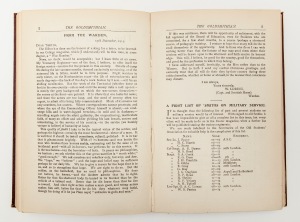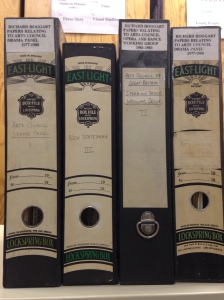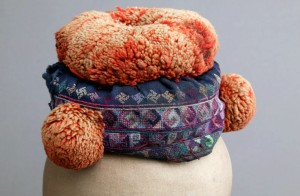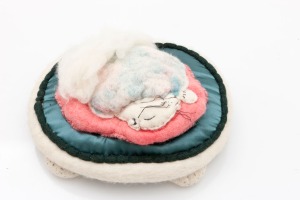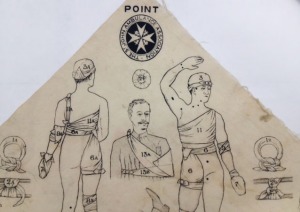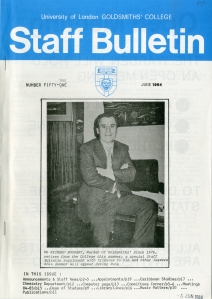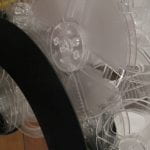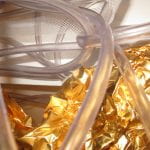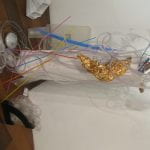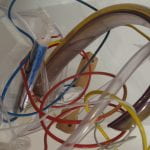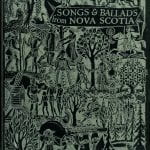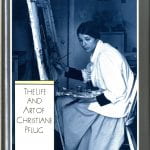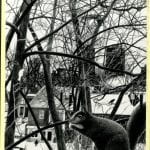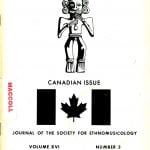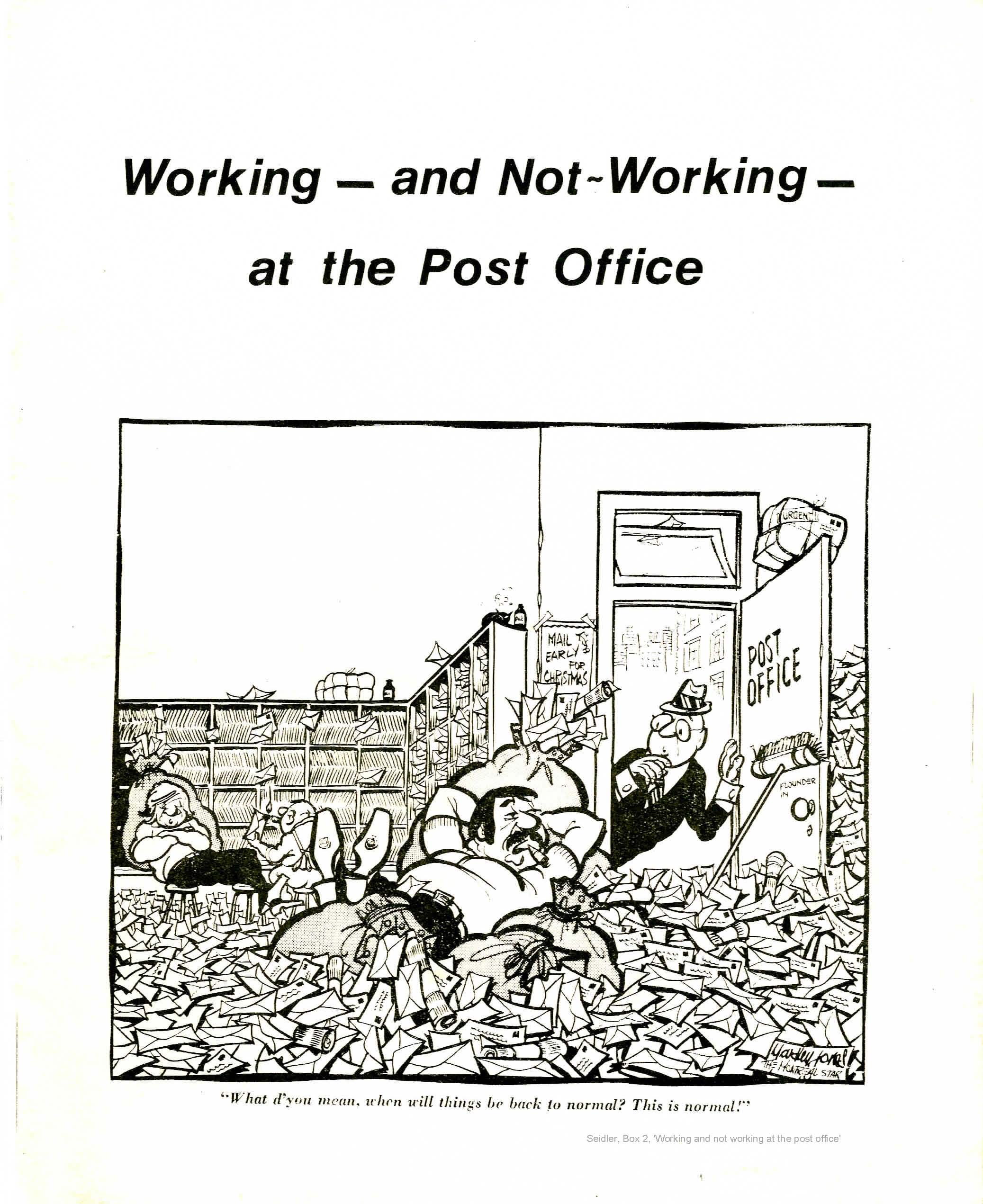Primary page content
Goldsmiths At War: The Goldsmithian.
Richard Hoggart : Archive Exhibition and Cataloguing project
Explore your Archive: Daphne Oram and the Oram Collection
The particular item on display in this ‘selfie’ is Daphne Oram’s (1925 – 2003) personal computer, one of many items from Oram’s personal collection Special Collections is pleased to house within its archives. Oram was a central figure in early British experimental electronic music, famous for her involvement with the widely influential BBC Radiophonic Workshop and the eponymous Oramics computer music system she designed.
A gifted musician, Oram decided against pursuing a career in classical music, turning down a place at the Royal College of Music to join the BBC and co-found the BBC Radiophonic Workshop. During this period she developed a combined interest in technology and artificially produced sounds. Oram’s approach was informed by the rigid modernist technique of Pierre Schaffer’s musique concrète and other avant-garde musical aesthetics of the time. Such musical movements challenged dominant modes of classical music composition by introducing sonic details procured from the technological and cultural upheavals of post-war society. She would weave these experimental influences into her compositions with the BBC Radiophonic Workshop. During this period she also began the research that would lead to the creation of Oramics, a new technique of sound synthesis. Not only was Oramics one of the earliest forms of electronic sound synthesis, it was also innovative through its pioneering of the audiovisual interface in music production.
Daphne would leave the BBC in 1959, though her research on the Oramics project would continue. The completed Oramics machine required the composer to physically draw onto a synchronised set of ten 35mm film strips overlaying a series of photo-electric cells. These drawings, when processed through the Oramics machine, would generate electrical charges to control amplitude, timbre, frequency and duration. Oramics was remarkable for being one of the first devices to engineer sound from electricity, an undoubted influence on the synthesizers and digital music suites of today that are able to produce a similar spectrum of synthetic sound. It should be noted that there was something of a difference in size however, as the Oramics machine was far from a portable device – requiring an entire room to be fully operational. The complete Oramics machine can currently be viewed at the Science Museum in London (more information here).
Here at Special Collections in Goldsmiths Library, we hold many materials relevant to Oram’s work, taken from her own personal archive. In 2007, Goldsmiths College collaborated with the Sonic Arts Network to bring this collection into the academic community where it can be properly studied and developed. These include not just the personal computer shown in the ‘selfie’ but a whole plethora of useful materials relating to her work. This includes papers on her work at the BBC, design notes on the Oramics system, personal photographs, musical scores and scripts and much more.
You can learn more about the Oram archive and our various other collections here, or directly get in touch by emailing Special Collections or calling (+44) 020 7717 2295.
Talking Textiles
Talking Textiles is a once monthly lunch time get-together for anybody interested in textiles or curious to find out more. A small selection of textiles from the Goldsmiths Textile Collection is available for viewing and discussion at the Constance Howard Gallery. For those keen to be involved further, there is the opportunity to research a chosen textile and to share findings or questions at the following session.
The Goldsmiths Textile Collection includes works by Goldsmiths alumni and other textile artists, collections of teaching samples, ethnographic and historical textiles and dress and print and archival materials relating to textiles. A diverse range of examples is on view at Talking Textiles and over the next few sessions will include a boy’s hat made by the Hmong people of Northern Thailand, an illustrated St. Johns Ambulance bandage from WW1, a felt sculpture by the artist Dorothy Linton and a sample of Victorian beetle wing embroidery.
After the viewing, there is a chance to share your own textile projects and chat with other textiles enthusiasts over tea and coffee. The event is open to the public, as well as Goldsmiths students and staff and is an opportunity to foster relationships and share knowledge across disciplines and between different communities interested in textiles.
The next event is at 1 pm on Thursday 13th November.
For more information visit www.gold.ac.uk/textile-collection
Women of Colour Index Project: Gillian Elinor Donation
We are extremely excited and pleased to announce the commencement of the Women of Colour Index Project which has been made possible by the kind donation of Jonathan Rosenhead in the name of Gillian Elinor, a feminist activist and arts educator responsible for Feminist Arts News and contributor and supporter of Women’s Arts Movement, Women Artists Slide Library (now the Womens Art Library located in Goldsmiths Special Collections) and the Head of Art and Design at UEL.
This is a 12 month project focused upon a collection within the Women’s Art Library charting the emergence of Black Women’s art in the UK during the ‘Critical Decades’ of the 1980s and 1990s. The collection comprises ephemera, press cuttings, exhibition catalogues and slides of individual artworks and installations. The project will create archival records of the material to be widely shared online through our own Archive databases and Archives Hub. In addition the collective X Marks The Spot in collaboration with original coordinator Rita Keegan will explore new connections and themes that have emerged in the subsequent years and relaunch the Women of Colour Index. The final phase will be an event celebrating the Women of Colour Index Project and The Gillian Elinor Donation.
Regular updates on the project will be available through the Library blog, for more information please contact Althea Greenan a.greenan@gold.ac.uk
Ada Lovelace
Ada Lovelace Day: Celebrating the achievements of women in science, technology engineering and maths.
Augusta Ada King,
Countess of Lovelace (10 December 1815 – 27 November 1852)
English mathematician and writer, and collaborator on Charles Babbage’s early mechanical general-purpose computer, the Analytical Engine.
Ada Lovelace Day this year will be held on Tuesday 14 October. Over the coming year, FindingAda.com will develop into a resource for women in science, technology, engineering and maths (STEM), as well as for parents, teachers and lecturers who care about encouraging girls and young women to enter the STEM disciplines.
For more information on FindingAda and Ada Lovelace:
Web: http://findingada.com/
Twitter: @FindingAda
Facebook: FindingAda
Interested in learning more about women in STEM ?
Have a look at our reading list of books and special collections in the Library:
Material on Ada Lovelace
Conceving Ada
Leeson, Lynn Hersman. (1997)
(DVD Collection) 791.43737
Ada Byron Lovelace: To Dream Tomorrow
Arnholtz , C Frances, Fuegi, J. (2003)
(DVD Helpdesk Collection) A34
Documenta (13): Ada Lovelace
Krysa, Joasia. (2011)
(Special Collections) SCP 709.051 DOC/LOV
Ada a Life and a Legacy
Stein, Dorothy. (1987)
510.92 STE
The Bride of Science
Woolley, Benjamin. (1999)
510.92 WOO
Francis, J Fuegi J. 2003 Lovelace and Babbage and the Creation of the 1843 ‘Notes’ IEEE Computer Society Washington DC
Charles Babbage Pioneer of the computer
Hyman, Anthony. (1982)
510.92 HYM
Material on Daphne Oram
The Daphne Oram Archive
Please refer to http://www.gold.ac.uk/library/collections/special-collections/ or come a speak to a member of staff in the Special Collections and Archives office.
An individual note : of music, sound and electronics
Oram, Daphne (1972)
(Special Collections) 789.9 ORA
The Woman from New Atlantis (Article)
Wilson, Dan. The Wire Magazine London (No. 330, Aug 2011)
780.5 Periodicals
Daphne Oram
(Special Collections) Women’s Art Library Artist File
The Daphne Oram Tapes, Vol. 1
Oram, Daphne (2012)
CD 7838
Oramics / Daphne Oram.
Oram, Daphne (2007)
CD 6052-53
Four aspects / Daphne Oram.
Oram, Daphne. 2003.
CD 5011-12
Not necessarily “English music” : a collection of experimental music from Great Britain, 1960-1977.
Leonardo music journal (Vol 11, 2001) CD 7457
An anthology of noise and electronic music : second a-chronology, 1936-2003.
Sub Rosa (2003)
CD 5011-12
Women in Science, Engineering, Mathematics and Technology
Women Composers and Music technology in the United States
Hinkle-Turner, Elizabeth. (2006)
Ashgate Aldershot
780.973082 HIN
Women of Mathematics: A Bibliographic Sourcebook
Campbell, P Grinstein, L. (1987)
Greenwood Press Inc. Westport
510.92 WOM
Women in Science, Engineering and Technology: Three Decades of UK Initiatives
Alison Phipps (2008)
Trentham Books Ltd
331.4815 PHI
Women in Science: A Social and Cultural History
Ruth Watts (2007)
Routledge 509.2 WAT
Cyberfeminism and Artificial Life
Kember, Sarah. (2003)
Routledge London
113.8 KEM
Complexities: Women in Mathematics
Anne M. Leggett (2005)
Princeton University Press
510.92 COM
Scientists Anonymous: Great Stories of Women in Science
Patricia Fara (2007)
Wizard Books
(School Practice Collection) 509.2 FAR
Feminism and Science (Oxford Readings in Feminism)
Evelyn Fox Keller (Editor), Helen E. Longino (1996)
OUP Oxford
Nobel Prize Women in Science: Their Lives, Struggles, and Momentous Discoveries
Sharon Bertsch McGrayne (2001)
Henry (Joseph) Press
Margaret Alic 2001 Hypatia’s Heritage: A History of Women in Science from Antiquity to the Late Nineteenth Century The Women’s Press Ltd
H. Patricia Hynes 1990 Reconstructing Babylon: Essays On Women And Technology. Earthscan Publications Ltd
Portrait of Ada Lovelace is courtesy of Creative Commons
Richard Hoggart
Ever roamed around the Richard Hoggart Building and wondered who he was?
Richard Hoggart was The Warden for Goldsmiths between 1976-1984, and today in the Library we are celebrating what would have been his 96th birthday.
Hoggart, who sadly passed away earlier this year, was certainly an extraordinary man who had an extraordinary career. Starting as an lecturer in the English Literature department at Hull University, he then moved on to New York’s Rochester University, followed by Leicester University, and in 1964 established the Centre for Cultural Studies at Birmingham University. In 1970, he moved away from academia to take on the role of Assistant Director General at the UNESCO headquarters in Paris; but it was his last position before retiring, as Warden at Goldsmiths, that eventually that drew him back to academia.
Throughout his career he was not only a member of numerous public bodies, boards and committees including the Arts Council, The New Statesman, the Pilkington Committee on Broadcasting and the Royal Shakespeare Company, but also a broadcaster, and author of a long list of articles, essays and books, including his most famous work ‘The Uses of Literacy’ published in 1957.
In 1960 Hoggart was called as an expert witness for in the ‘Lady Chatterley Trial’, defending Penguin Books decision to publish D.H. Lawrence’s novel. In 2006 Andrew Davies dramatised the trial in The Chatterley Affair, with David Tennant taking the role of Hoggart.
On Friday the 31st of October Goldsmiths will be hosting a memorial event to celebrate the life and work of Richard Hoggart. Throughout the day Goldsmiths will be screening The Chatterley Affair and host a series of talks on the life and work of Richard Hoggart. More details to follow via http://www.gold.ac.uk/calendar/ .
Richard Hoggart Archive: Cataloguing Project
Starting in October, Special Collections and Archives will be working on a project to catalogue papers of Richard Hoggart here in the Library. For more information on the Hoggart Archive please contact Special Collections and Archives at special.collections@gold.ac.uk .
Margaret Jennings: The Living, Taking and Giving Back Library
A Participatory Experience
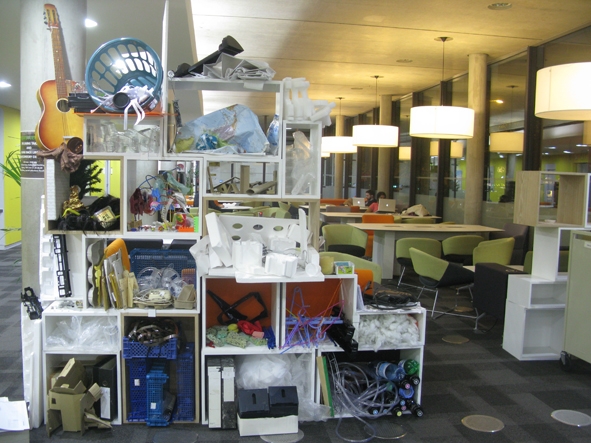
Art student, Margaret Jennings, has transformed the book shelves at the entrance of the Library into an alternative living library of found materials.
The discarded items have been collected, categorized, arranged and offered for re-use by others. People are invited to take objects away and replenish the shelves with those that they find.
‘…juxtaposed against the historically and culturally revered library context, the newly categorised and arranged objects, evoke the beginnings of a re-appropriated transformative journey of stuff’ Margaret Jennings.
People are encouraged to re-work and transform the objects they take into new forms, using their imagination in a way which prompts questioning over the value of discarded materials and their relationship with consumerism.
Through this playful and participatory work, the artist prompts reflection upon a throw-out-buy again mentality and suggests alternatives for environmental responsibility.
Margaret is documenting participation in the Living Library. Images of objects taken and transformed, as well as objects given back to the library will be shared via this blog. Please e-mail l.cannon@gold.ac.uk to contribute your images.
- Sculptural outcomes from The Living, Taking & Giving Back Library
- Sculptural outcomes from The Living, Taking & Giving Back Library
- Sculptural outcomes from The Living, Taking & Giving Back Library
- Sculptural outcomes from The Living, Taking & Giving Back Library
For more information about Exhibitions in the Library visit www.gold.ac.uk/library/exhibitions
Canada Day
Vic Seidler Archive
The Vic Seidler Archive is part of Special Collections & Archives in Goldsmiths Library. It includes a treasure trove of ephemera on topics like gender and labour, including many pamphlets, newsletters, magazines and papers produced by groups advocating for social change. Ainsley Banks, a history student doing a work experience placement in Special Collections, had the chance to look through the collection, and shares his thoughts on one of the items in this guest post.
“Working and not working at the post office”
This is a booklet created in the mid-70s, written by a worker at the Toronto post office. It basically consists of him complaining about work, how work affects his life at home and all of his schemes put in place in order to work as little as possible. I suspect a little bias is present in this piece as the booklet was written for his fellow workers and the author was encouraged by them to publish more copies. Just as everyone likes to complain about their job, it is also true that everyone likes to impress or please their friends and so this may have been exaggerated slightly in order to do this and also to make this job more enjoyable. Overall I found this a very interesting read and would recommend coming down to Special Collections, especially if your course looks at workers or working in general, as the Seidler collection has many journals and documents on this subject.
Ainsley Banks
